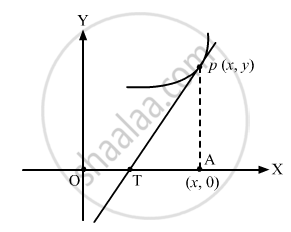Advertisements
Advertisements
प्रश्न
Find the equation of the curve which passes through the point (1, 2) and the distance between the foot of the ordinate of the point of contact and the point of intersection of the tangent with x-axis is twice the abscissa of the point of contact.
उत्तर

It is given that the distance between the foot of ordinate of point of contact (A) and point of intersection of tangent with x-axis (T) = 2x
\[\text{Coordinate of }T = \left( x - y\frac{dx}{dy}, 0 \right)\]
\[\Rightarrow y - 0 = \frac{dy}{dx}\left(x - \left( x - y \frac{dx}{dy} \right) \right)\]
\[\Rightarrow y \frac{dx}{dy} = 2x\]
\[\Rightarrow \int\frac{dx}{x} = 2\int\frac{dy}{y}\]
\[\Rightarrow \ln x = \ln y^2 + \ln c\]
\[x = c y^2 \]
\[\text{As the circle passes through }\left( 1, 2 \right).\]
\[1 = c \times 2^2 \]
\[ \Rightarrow c = \frac{1}{4}\]
\[ \Rightarrow 4x = y^2\]
APPEARS IN
संबंधित प्रश्न
Prove that:
`int_0^(2a)f(x)dx = int_0^af(x)dx + int_0^af(2a - x)dx`
Verify that y = \[\frac{a}{x} + b\] is a solution of the differential equation
\[\frac{d^2 y}{d x^2} + \frac{2}{x}\left( \frac{dy}{dx} \right) = 0\]
Show that y = ex (A cos x + B sin x) is the solution of the differential equation \[\frac{d^2 y}{d x^2} - 2\frac{dy}{dx} + 2y = 0\]
For the following differential equation verify that the accompanying function is a solution:
| Differential equation | Function |
|
\[x^3 \frac{d^2 y}{d x^2} = 1\]
|
\[y = ax + b + \frac{1}{2x}\]
|
For the following differential equation verify that the accompanying function is a solution:
| Differential equation | Function |
|
\[y = \left( \frac{dy}{dx} \right)^2\]
|
\[y = \frac{1}{4} \left( x \pm a \right)^2\]
|
Differential equation \[\frac{d^2 y}{d x^2} - 2\frac{dy}{dx} + y = 0, y \left( 0 \right) = 1, y' \left( 0 \right) = 2\] Function y = xex + ex
Solve the following differential equation:
\[y\left( 1 - x^2 \right)\frac{dy}{dx} = x\left( 1 + y^2 \right)\]
Solve the following differential equation:
\[y e^\frac{x}{y} dx = \left( x e^\frac{x}{y} + y^2 \right)dy, y \neq 0\]
Find the solution of the differential equation cos y dy + cos x sin y dx = 0 given that y = \[\frac{\pi}{2}\], when x = \[\frac{\pi}{2}\]
If y(x) is a solution of the different equation \[\left( \frac{2 + \sin x}{1 + y} \right)\frac{dy}{dx} = - \cos x\] and y(0) = 1, then find the value of y(π/2).
\[\frac{dy}{dx} = \frac{y}{x} + \sin\left( \frac{y}{x} \right)\]
Solve the following initial value problem:-
\[\left( 1 + y^2 \right) dx + \left( x - e^{- \tan^{- 1} y} \right) dx = 0, y\left( 0 \right) = 0\]
Solve the following initial value problem:-
\[\frac{dy}{dx} + y\cot x = 2\cos x, y\left( \frac{\pi}{2} \right) = 0\]
In a simple circuit of resistance R, self inductance L and voltage E, the current `i` at any time `t` is given by L \[\frac{di}{dt}\]+ R i = E. If E is constant and initially no current passes through the circuit, prove that \[i = \frac{E}{R}\left\{ 1 - e^{- \left( R/L \right)t} \right\}.\]
Find the equation of the curve such that the portion of the x-axis cut off between the origin and the tangent at a point is twice the abscissa and which passes through the point (1, 2).
Find the equation to the curve satisfying x (x + 1) \[\frac{dy}{dx} - y\] = x (x + 1) and passing through (1, 0).
The slope of a curve at each of its points is equal to the square of the abscissa of the point. Find the particular curve through the point (−1, 1).
Write the differential equation obtained by eliminating the arbitrary constant C in the equation x2 − y2 = C2.
The differential equation
\[\frac{dy}{dx} + Py = Q y^n , n > 2\] can be reduced to linear form by substituting
The integrating factor of the differential equation \[\left( 1 - y^2 \right)\frac{dx}{dy} + yx = ay\left( - 1 < y < 1 \right)\] is ______.
y2 dx + (x2 − xy + y2) dy = 0
Find the particular solution of the differential equation `"dy"/"dx" = "xy"/("x"^2+"y"^2),`given that y = 1 when x = 0
Solve the following differential equation.
x2y dx − (x3 + y3 ) dy = 0
Solve the following differential equation.
y dx + (x - y2 ) dy = 0
Choose the correct alternative.
The differential equation of y = `k_1 + k_2/x` is
Choose the correct alternative.
The solution of `x dy/dx = y` log y is
Choose the correct alternative.
The integrating factor of `dy/dx - y = e^x `is ex, then its solution is
A solution of a differential equation which can be obtained from the general solution by giving particular values to the arbitrary constants is called ___________ solution.
Solve the differential equation:
dr = a r dθ − θ dr
Select and write the correct alternative from the given option for the question
The differential equation of y = Ae5x + Be–5x is
Solve the following differential equation `("d"y)/("d"x)` = cos(x + y)
Solution: `("d"y)/("d"x)` = cos(x + y) ......(1)
Put `square`
∴ `1 + ("d"y)/("d"x) = "dv"/("d"x)`
∴ `("d"y)/("d"x) = "dv"/("d"x) - 1`
∴ (1) becomes `"dv"/("d"x) - 1` = cos v
∴ `"dv"/("d"x)` = 1 + cos v
∴ `square` dv = dx
Integrating, we get
`int 1/(1 + cos "v") "d"v = int "d"x`
∴ `int 1/(2cos^2 ("v"/2)) "dv" = int "d"x`
∴ `1/2 int square "dv" = int "d"x`
∴ `1/2* (tan("v"/2))/(1/2)` = x + c
∴ `square` = x + c
Solve `x^2 "dy"/"dx" - xy = 1 + cos(y/x)`, x ≠ 0 and x = 1, y = `pi/2`
The integrating factor of the differential equation `"dy"/"dx" (x log x) + y` = 2logx is ______.
